Psoriasis is one of itching dermatoses, and an unpleasant skin manifested by rashes on the body. They are almost not hurt, but itch and unaesthetic look, therefore, to provide the people a lot of inconvenience. Let's consider, what are the types of Psoriasis are, how they differ and how to cure the disease .
Classification of Psoriasis according to ICD-10
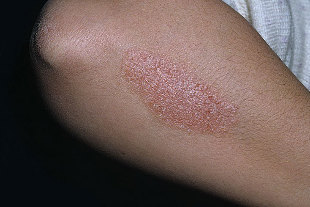
According to the international classification of diseases with the Psoriasis-Code L40. This means that it is on papuloscentus disorders (from Lat. papula - "fluff" and squama - "the shed").
L40.0 Psoriasis vulgaris
Other name: plaque-like. Diagnosed in almost 90% of the patients. Manifested by papules scaly structure. Plaques can be gray, silvery white color or pink. Papules sometimes grow, connect with the neighboring and formed around the "island" or "lake".
L40.1 pustular psoriasis generalized
Other names: exudative, Impetigo, disease Tsumbush. Is considered to be the most severe Form; it shows bubbles or bubbles filled with a flammable substance the exudate. If the bubble will show, and inside the infection is, psoriasis acquires the eiterigen character. Most of these bubbles are on the hands and feet, more rarely on the body.
L40.2 Acrodermatitis resistant
Other Names: Dermatitis Crocker, Dermatitis Settona. The contents of the pustules (pustules), which is not this type of psoriasis, sterile, therefore, acrodermatitis contagious. A major disadvantage is that the Plaques may form on the fingers, because of what flake off the nails.
L40.3 Pustulosis of palms and soles
Other names: pustular bactericides. According to the title it is clear that this type of psoriasis affects the soles of the feet and palms of the hands. They are large and small pustular formations, which gradually grow and rise on the square. The contents of the pustules are sterile, but pustular bactericides is considered to be a serious disease. The treatment is complicated by the fact that abscesses of the mechanical action (wear and break when to go).
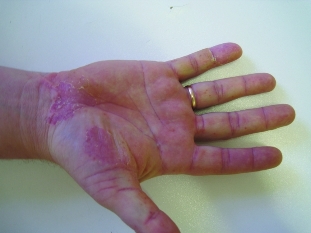
L40.4 guttate Psoriasis
Manifested small purple dots, scattered over the hips, the lower legs, forearms , shoulders, head, neck and back. Often of streptococcal tonsillitis or Pharyngitis develops after the transfer .
L40.5-7 arthropathic Psoriasis
Synonyms: Psoriatic Arthropathy, Psoriatic Arthritis. The disease affects about 10% of all patients with Psoriasis. Affects the joints and connective tissue . Externally, swelling of the phalanges is manifested in the fingers of the hands and feet. Rare hip, humeroscapular joints, knee joints and the spine. Sometimes, disability results: the Patient can not move.
L40.8 Other psoriasis
Other names: inverse Psoriasis. Smooth inflamed patches, the not and scrolls located almost in skin folds and at the connection points (in the groin, the elbow, on the external genitalia, the mammary glands, etc.) manifests itself. Difficulties other treatment of Psoriasis associated with the constant friction in the affected areas, as well as the secretion of sweat in the folds of the skin. Often inverse Psoriasis is the cause of the fungal infection.
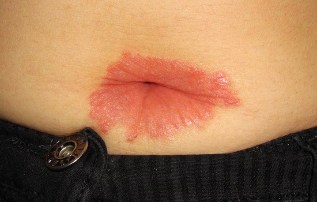
L40.9 psoriasis unspecified
For this purpose, all the other forms of Psoriasis that are not suitable for counting in a above.
There is still a separation of the Psoriasis category of clinical classification.
For the localization
Psoriatic Plaques can be located in different parts of the body
- The palms of the hands and soles of the feet. As before, these pustular bactericides (Code L40, it has been clarified.3).
- The Joints . About Psoriasis-Arthritis, and also told (by Code L40.5-7).
- The Mucous Membranes. Skin rashes can manifest themselves in the mouth, on the conjunctiva and the mucous membranes of the sex organs skins. Education in the Form of inflammatory cells in different forms, but with clear boundaries. A small swelling.
- Nails . Scientific name: psoriatic onychodystrophy. Symptoms: depressions and furrows on the surface of your nails, starting, protective nail plate, Peeling, crumbling, due to radiation of the capillary, itching near the nail of the skin.
- Hairy part of the head. This type is called seborrheic Psoriasis. Many confuse him with the shed , because one of the symptoms is skin an itchy head. But seborrheic psoriasis is much more unpleasant disease, because the skin bursts in the area of the ear cups, and distributed on the neck. All of this accompanied by the most itching and bruising when ripping the scab .
- The large folds of the skin or intertrigio psoriasis. Plaques form between the toes, in the groin, in the armpits, under the Breasts in women.
- The surface of the body. Such a phenomenon is called Erythro derma. This type of disease has a high mortality percentage , because due to the defeat of platelets, the skin loses its most important functions: thermal Regulation, Barrier protection, etc.
- Systemic failure is also dangerous, because it means the combination of several types of Psoriasis.
According to the clinical picture
According to manifestations of Psoriasis is:
- ordinary (vulgar);
- exudative;
- pustular;
- arthropathic;
- in the Form of erythroderma.
Psoriatic erythroderma
The entire typology considered above.
According to the stage of development
If you can psoriasis in terms of its staging , we can distinguish several stages.
Progressive Psoriasis
The stage of maturation of the inflammation. The following are the characteristics:
- the formation of smooth, pink papules;
- Itching;
- the inflammatory response to irritation, papules (scratch, trying to puncture with a needle or toothpick, etc.);
- At the beginning of each of the elements peeling.
Inpatient Psoriasis
Phase flows almost unchanged:
- new papules are formed;
- the old tiles do not grow in size;
- Scrub moderate.
Retrogressive Psoriasis
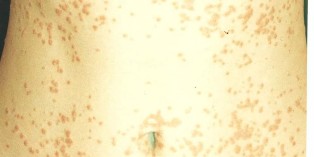
The last step, when the wound is overgrown. The healing begins with the middle. On the site of the former Plaque is a white depigmented spot is formed, which is not unpleasant, in addition to the aesthetic component.
By the seasonality of exacerbation
For the Psoriasis typical seasonal recurrences. In this connection distinguish:
- Summer Psoriasis: escalated under the action of solar radiation;
- Winter psoriasis; develops because of the severe cold, the effects on the skin;
- off-season psoriasis: the most severe Form with absence of periods of Remission. That is, the disease occurs year-round.
The symptoms of Psoriasis in summer shape
Place Skin Changes
In this classification, only 2 types of Psoriasis:
- limited - it takes less than 20% of the skin of the body;
- widely used - more than 20%;
- Universal - amazed the entire skin.
Classification of the National Science Foundation (USA)
Psoriasis varies and on the surface of the lesion:
- simple: defeat up to 2 % of the surface of the skin;
- Agent: 2-10%;
- heavy: more than 10%.
On the international index PASI
Table for the calculation of the index lesions of Psoriasis
The index PASI seems to be a number from 0 to 72, and it means the severe forms of Psoriasis of the weak clinical symptoms ( redness and flaking) to severe (bruising, suppuration). The index defines the specialists.
Psoriasis Treatment
Modern strategies for the treatment of the disease suggest the application of a whole complex of methods. It is important to three main objectives:
- achieve rapid primary positive results;
- keep track of the ineffectiveness of some techniques and to discard, but to continue to use what helps;
- you bring the patient to Remission.
Among the types of treatment of psoriasis are two:
- drug-free;
- drug.
Drug-Free Treatment
If use is possible without drugs, trying to doctors always. In the treatment of Psoriasis is a major role in several factors non-pharmacological therapy may play.Mode of the day
People should Psoriasis:
- try to stop Smoking;
- avoid alcohol (including beer);
- you wear clothes and sleep on linen is only made from natural substances.
- swap soap and washing powder on the core ;
- Nails cut short;
- wash only in the shower not to visit, a steam room, and Sauna;
- to eliminate try, Stress.
Diet for psoriasis
On the positive dynamics in the treatment of Psoriasis has a good effect nizkobelkovaâ diet, on the restriction of the Protein up to 30 G per day. Good results show the patients in once a week to unload. On this day you can eat 2-3 tomatoes, a few leaves of lettuce, 1 cucumber, 2-3 cups of green tea and 300 ml of hearty soda.
General principles of dietary diet Psoriasis mean:
- freshly squeezed juices from citrus fruits;
- fresh or steamed vegetables;
- not salted fish;
- Flour products made from rye flour;
- Dry Fruits, Fruits;
- Nuts (not more than 50 G per day).
You should also limit or exclude: meat, cereals, meat, sugar, potatoes, cheese, beans, oil, sweets, coffee.
Spa therapy
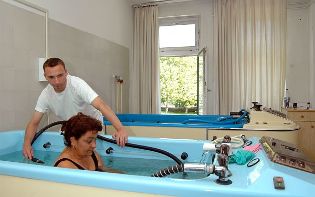
Spa therapy not by far the last place in the treatment of psoriasis. It is an excellent Anti-factor.
You treat the psoriasis at the dead sea .The main advantage of balneotherapy: the power of nature in the fight with disease. Water applications, a balanced diet, clean air and the soft sun - all of this reduces the symptoms of Psoriasis and increase in the Remission.
A version of balneotherapy in the case of varicose veins treatment Garra Rufa . These little creatures have no teeth, but his lips gently eat up particles of scaly skin and improve the ceiling of the microcirculation of the outer skin. In addition, the method gives excellent relaxing effect.
Physiotherapy
Under physio-therapeutic methods in dealing with Psoriasis of the skin the following:
- UV-irradiation;
- selective phototherapy ;
- Laser therapy ;
- Radio therapy;
- Cryotherapy (Cold Therapy);
- electric sleep;
- Phonophoresis .
With the help of physiotherapy possible good aesthetic results, because almost all of the methods mean different types of effects on the skin from the outside. The platelets are to form the cells of the healthy skin.
Photo chemotherapy
This method will be highlighted, because it is one of the most effective in the treatment of psoriasis. You can also use it in severe forms of the disease, the poorly to other physiotherapeutic procedures. Photo chemotherapy is radiation, the effect on the skin long wave UVA. Therefore, the other name of the method - PUVA therapy (PUVA) .
Drug Treatment
To help Psoriasis treatment with medicines also the major symptoms and the Patient is on the mend. There are three stages of the General (systemic) drug treatment of psoriasis:
- Emergency Therapy. In the period of acute course of the disease and is aimed at relieving the acute symptoms. Of medications, Steroid drugs and immunosuppressive agents are used, sometimes not .
- The transitional phase. Means the gradual Integration of the weaker preparations, and in the future the patient will be taken rates.
- Current supportive therapy.
The drug therapy includes and external application of drugs:
- Creams;
- the foams;
- Gels;
- Lotions;
- Ointments;
- Sprays.
Hormonal ointment on the Basis of hydrocortisone, for the treatment of Psoriasis

Medicines can be purchased or made according to the recipes of traditional medicine. The funds will remain in the open, or under an airtight dressing. The maximum effect in the treatment of psoriasis is a combination of pharmacological and non-pharmacological therapy. All the means and methods of the doctor selects.
Conclusion
As we can see, types and forms of Psoriasis very much, and determine what kind of disease, you precisely is very difficult. Therefore, the occurrence of primary symptoms, you should consult a doctor to determine the type of psoriasis and prescribe the appropriate treatment. The sooner you start to fight with Psoriasis, the faster and more effective the result will be.

























